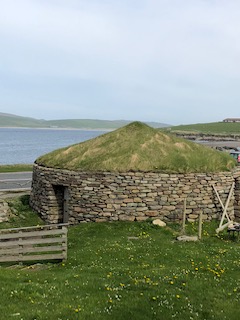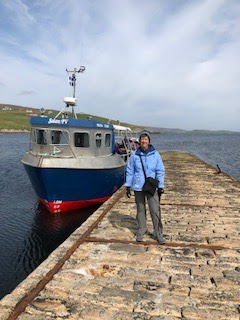Shetland Day 4
When the sun woke me at four a.m., I became convinced that living in the land of the midnight sun was not for me. But I like Shetland so much I might be able to force myself to adapt. If those river otters can live in saltwater, why can’t I trick myself into believing there are at least eight hours of true darkness?
Despite its rudely waking me, I was pleased and yet again a little surprised to find a bright, sunny day lying in wait. We didn’t have any firm plans, other than having to be at the ferry by half four (I’m forcing myself to refer to time like the locals in order to understand them more quickly).
During breakfast, I got online and picked a couple of things to do on South Mainland. There were three things that interested me, but I was fairly sure we’d only have time to do two. So we decided to visit a new (1970s) excavation of an iron age settlement, then take a ferry to Mousa Island to see their broch.
The drive was pretty spectacular, with even fewer people living in the area, taller hills, and steeper cliffs. The landscape was pretty unspoiled, with more vivid green grass than we’ve seen since we’ve been in the north. We even spotted a herd of cows, something that’s fairly uncommon.
I assume they don’t grow much in Shetland, but if they were to plant salad crops or something similar, I think they’d do all right. They’d certainly get enough daylight. It’s just the warmth they’d struggle with.
In case I haven’t mentioned this, the northern islands have one of the most narrow bands of high/low temps anywhere on earth. It’s never very warm, but it’s also never very cold. I think it’s around 30-45 in the winter and 40-60 in the summer. I’m certain an arctic wind makes that 30 degrees feel a heck of a lot colder, but you kind of expect that when you’re just to the left of Bergen, Norway. We’re at 60 degrees latitude here, btw, and NYC is at 40.
We found the iron age settlement just spitting distance from the runway for the airport. Actually, if they hadn’t been expanding the airport, they wouldn’t have stumbled upon it. It was discovered in the 70s, then they spent twenty years trying to decide what to do with it.
It’s obviously expensive to excavate a big area, but they got it together and started in the 90s. They’re pretty much done, but they know there’s another one just a few hundred feet away. Our guide said they wouldn’t excavate that one unless they had a strong belief it was different or more illuminating in some significant way.
The site we looked at was around 2000 years old, and was probably built by people that haven’t been named. When you don’t have written language, and you have no literate neighbors, you’re pretty much left out of the history books.
Anyway, these nameless builders took local stone and built a very small village, with a broch as the focal point.
Brochs are found only in Scotland, and they have a bunch, mostly on the west coast and the islands. We’ve seen close to ten, and we haven’t spent a lot of time here, so they’re not rare.
They’re awfully cool, though, showing the amazing skills these folks had with stone. These were iron age people, but there were no marks on the stones to indicate they used iron tools. They split these massive rocks with harder stone, managing to built an enclosure that was tall enough to allow people to stand up inside, and sturdy enough to have remained partially intact for 2000 years.
I like brochs because no one’s sure why they exist. They were agrarian people, and living in such a remote area that they probably didn’t need much defense—until the Vikings got there. But that was hundreds of years after these things were built. They didn't know what was in store for them <s>.
So experts are fairly sure the brochs weren’t created for defense. They don’t have any obvious religious significance, and in this case the broch is separate from their living quarters, so they didn't sleep in it.
Most likely, brochs were temples of some sort, but it’s not clear and it likely won’t become clear. I really like having something big and complex that we don’t understand and probably never will. Keeps us humble <s>.
We only spent about 45 minutes at the settlement, since we wanted to make that ferry. So after waiting for a plane to take off so we could drive across the runway (!), we drove back north a bit.
The ferry was on the small side, but they had room for us. There were around forty people already waiting, almost all of them outfitted for a safari. Everyone had on those sturdy, wrinkle-free travel pants, multiple rainproof jackets, hiking boots, and binoculars. A few had long-lensed cameras, tripods and all sorts of very heavy junk. They were a mix of Australians, Austrians, English, and a couple of Scots, and most were birders.
Mousa Island is a hotspot for birds, and there’s a massive colony of storm petrels that nest in the rocks by the sea and within the walls of the broch.
I like birds a little more than the next guy, but the broch was what drew me in. It’s almost its original height, which is rare. They’ve become shortened not because of time, weather, or poor construction. Finding a huge supply of squared-off rocks has been too tempting for farmers to resist, and they’ve been pilfering from the brochs for as long as they’ve existed.
I guess no one needed to steal these particular stones. The shore was littered with so many it would have been easier to take the ones on the ground than try to knock this forty-seven foot tall broch down.
This is the first one we’ve seen where you can walk up the stairs exactly like the builders did. If I were in charge of protecting this precious building I don’t think I’d leave it open to people tromping up those stairs all day long, but I suppose it’s been fine for so long they consider it indestructible.
It was created by building an inner and an outer wall, then lacing in longer stones to connect both walls and keep it stable.
This broch might have had religious significance, but it had also been inhabited. People probably lived between the two walls, climbing up the stairs we trod today to get to their little nooks. It was close to a religious experience to be in the place that obviously meant an awful lot to people who lived so long ago.
If you were tasked with building a monumental place like this, you didn’t have time for fishing or farming. That was probably foisted off on the women, who couldn’t have been strong enough to toss those stones around.
It must have taken at least a decade to build, and I bet we weren’t standing in version 1.0. There had to have been a few mishaps when you didn’t have computer modeling to tell you what stone went where.
Anyway, it was very cool, and we climbed up to the top, even though the stairs were only three or four inches wide. There was a very handy rail someone had installed a few decades ago, and I hung on tenaciously on the very dim lower levels.
Then we got to the top and it was glorious! They’ve had to install wire netting over the top to keep out the bigger birds, who would eat the eggs of the storm petrels, but that only slightly hampered the experience by reminding you you’re not in the year one a.d.
After we collected everyone for the ferry, we did a quick ride-around and saw the buildings from the water. The large house near the broch was ostensibly owned by the Piper family in the early nineteenth century. Mr. Piper was trying to keep Mrs. Piper from drinking herself to death, so he exiled her from Lerwick to the island.
But even back in the day a motivated woman could get liquor, and she prevailed upon Danish sailors to keep her supplied. When she died of her disease, Mr. piper remarried. His second wife liked living on an island with only farm laborers and servants, and they remained until the 1840s, when they moved back to Lerwick. That depopulated the island completely—save for the storm petrels, arctic skuas, and a few tourists crossing the sound on a ferry.
On the way back to our Ferry to Orkney we passed this announcement of a wedding. Very unique.
SXM & CDN
















The James & Amy wedding looks a wee bit less formal than the Harry & Meghan event that took place the next day a bit to the south.
ReplyDelete